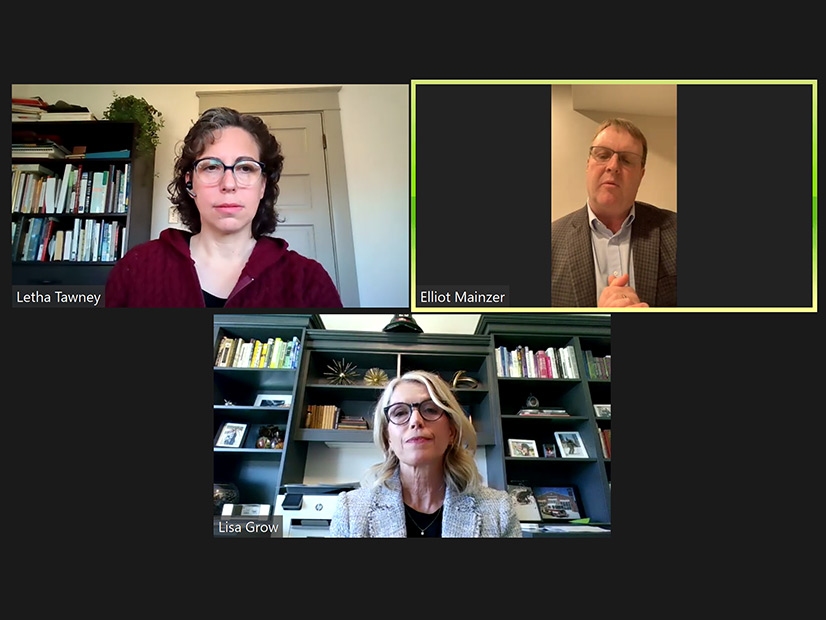Western states must work together to share renewable resources and build transmission to avoid blackouts like those that happened in California and Texas, speakers said Friday during a roundtable discussion hosted by the Western Energy Imbalance Market’s Body of State Regulators (BOSR).
Body Chair and Oregon Public Utility Commissioner Letha Tawney moderated a discussion between CAISO CEO Elliot Mainzer and Idaho Power CEO Lisa Grow.
The creation and expansion of CAISO’s EIM showed what entities across the West could do by working together, Grow said. The interstate exchange of energy has saved market participants $1.18 billion since 2014. Now, with more states enacting clean-energy mandates and interests aligning, the West will need to build more transmission, she said.
“Transmission, in my mind, is the great enabler of all of this,” Grow said.
“The notion that everyone is just going to build all the resources they need in their [balancing authority areas] to get to clean [energy], I don’t think is necessarily the best way to think about it,” she said. “When we really think about where the richest fuel sources are, the Pacific Northwest has hydro. The Desert Southwest has solar. Wyoming and Montana have wind. That’s where the really good stuff is, and so, when you think about how we connect it, it’s transmission.”
The rolling blackouts in California in August and, to a lesser extent, the blackouts in Texas this winter, were examples of “what happens when you don’t have enough transmission to move resources around to where they’re needed,” Grow said.
Transmission constraints were one factor that CAISO and state agencies cited in their report on the root-cause analysis of the Aug. 14-15 blackouts in California. (See CAISO Says Constrained Tx Contributed to Blackouts.)

BOSR Chair Letha Tawney, CAISO CEO Elliot Mainzer and Idaho Power CEO Lisa Grow discussed issues facing the West. | EIM BOSR
Building transmission is difficult, but “it’s just such a foundational requirement to get to where we all want to go and to unleash the economic potential” of transitioning to clean energy while ensuring reliability, Grow said.
“Lord knows we’ve been trying to build some transmission lines, it seems like, for most of my career,” she said. “It is a long, drawn-out process, and I would just ask everyone to think about how we can reduce some of the barriers if we’re all trying to get to that same goal.”
Mainzer said: “I couldn’t agree more.”
In his previous job as head of the Bonneville Power Administration and now at CAISO, Mainzer said he has seen the importance of “interconnectedness and optionality and resource development, resource diversity, resiliency — those are all becoming so increasingly important.”
Looking to 2045 — the year California is required by Senate Bill 100 to supply all retail customers with clean energy — “I think there’s a real recognition that having that additional capability and exchange of capacity, diversity and optionality with the rest of the West is going to be really important,” he said. “The West has been planning its transmission system for a long time. I think people look at the map and they know a lot of the big paths. Some of them are even permitted and almost ready to go. It’s how do you move from transmission planning, which is incredibly important, to transmission construction and the energization.”
At CAISO, “we’re really looking forward to accelerating the pace of transmission construction and working with the [California] Energy Commission, working with the [California Public Utilities Commission], working with all of you across the West to … see if we can put some commercial activity together.”
Tawney asked Mainzer and Grow how not having a Western RTO — and relying on the hybrid structure of the EIM, a real-time interstate trading market — could affect the shift from transmission planning to construction.
Efforts to create a Western RTO have been halting and unsuccessful, Grow said. But the EIM “is showing how you can have this organic growth … whether or not you ever get to the full RTO.”
“This is a way that we can incrementally grow … as we build the system out. With that in mind, I actually think it’s a facilitator” of transmission construction, she said.
Mainzer said, “I agree with that a lot. I see the two things [EIM and transmission] as being very complimentary.
“If you think about a big piece of the value proposition of the Energy Imbalance Market, then your transmission interconnectivity that we already have with the West” is a big part of it,” he said.
“Just last week, when we incorporated [the Los Angeles Department of Water and Power] into the EIM, that’s a nice big piece of additional transfer capability between the ISO and L.A.,” Mainzer said. “We’ve got that same thing happening with [Public Service Company of New Mexico] now.” (See Expansion Takes EIM into LA, New Mexico.)
“As you think about the other regions, and we open up the EIM, we could take the existing transmission topology that we’ve got and we can ask ourselves, ‘What are some other enhancements, reinforcements, new builds that could further open up resource development, diversification, capacity capability and strengthen the ability to exchange more energy, to unlock more economic and environmental value?’” he said.
“Part of it is just about raw access to resources.” California may need an additional 80 GW of bulk generation to meet its clean energy goals by 2045, according to recent projections, he said.
“That’s a lot of resources. We are going to need to access capability from out of state and transfer it and import and export economic and environmental capability,” Mainzer said. “So we just have get to really real about where is the system today … what are the most potent and effective line expansions … so that we can unlock economic value.”



